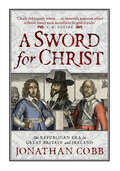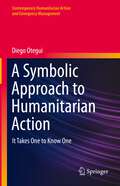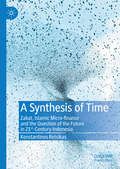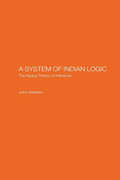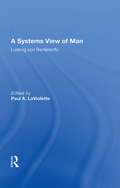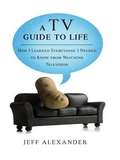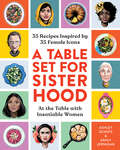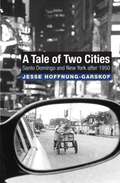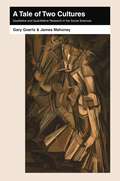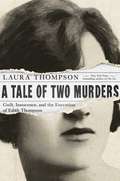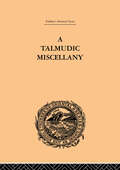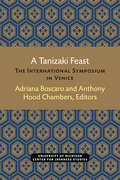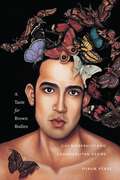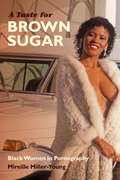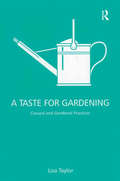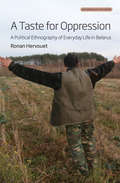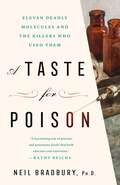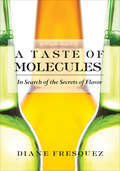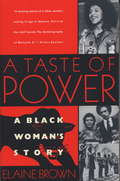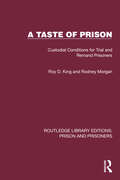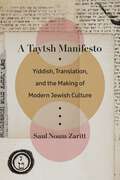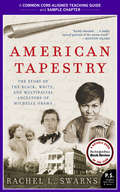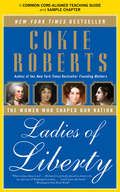- Table View
- List View
A Sword for Christ: The Republican Era in Great Britain and Ireland
by Jonathan CobbThe fifteen-year period between 1645 and 1660 was one of the most dynamic in British history, during which the republican Commonwealth and Cromwellian Protectorate attempted to create a new type of ‘Godly’ state after the execution of Charles I. Drawing on the latest research and established sources, as well as the works and diaries of contemporaries such as John Evelyn, Lucy Hutchinson and Samuel Pepys, A Sword for Christ offers a new and stimulating perspective on these extraordinary years. Key personalities such as Sir Thomas Fairfax, the Marquis of Argyll, Charles II and, of course, Oliver Cromwell himself – one of the most contentious figures in history – are re-appraised and brought vividly to life. In addition to exploring the religious and political debates which shaped the era and the military culture which defined it, the book also considers how society was profoundly affected by the upheaval caused by the civil wars; the relations between what was essentially an English republic and its Irish and Scottish neighbours; and the ethos of the New Model Army and the navy.
A Symbolic Approach to Humanitarian Action: It Takes One to Know One (Contemporary Humanitarian Action and Emergency Management)
by Diego OteguiThis book aims to present an alternative view of humanitarian action. It adds to current conversations and dilemmas within the humanitarian sphere by departing from traditional views that consider humanitarian interventions as a concrete human activity aimed at providing relief to disaster victims. Much differently, it invokes the idea that humanitarian action is also a cognitive process. In this process, both humanitarians and disaster survivors alike, unknowingly, apply historically, societally, and culturally defined symbolic constructions to make sense of post-disaster information and to make decisions. In the specific case of humanitarian workers, these symbolic constructions influence how they understand their post-disaster reality, including how they relate to those they consider to be in pain or distress. This way of looking at humanitarian action builds upon a robust theoretical framework called Institutional Logics, which helps us identify and interpret how individuals make sense of their reality. So it brings the complex world of the individual into a discussion that generally considers the organization as the unit of analysis. Studying humanitarian action through this alternative lens makes it easy to see that objective and verifiable post-disaster information is a necessary but not a sufficient condition to design humanitarian interventions, let alone assess their value and benefits. A Symbolic Approach to Humanitarian Action: It Takes One to Know One aims to bridge the gap between research and practice in humanitarian action by translating academic knowledge into an accessible format that can be used by practitioners to improve their work on the ground.
A Synthesis of Time: Zakat, Islamic Micro-finance and the Question of the Future in 21st-Century Indonesia
by Konstantinos RetsikasThis book is an anthropological investigation into the different forms the economy assumes, and the different purposes it serves, when conceived from the perspective of Islamic micro-finance as a field of everyday practice. It is based on long-term ethnographic research in Java, Indonesia, with Islamic foundations active in managing zakat and other charitable funds, for purposes of poverty alleviation. The book explores the social foundations of contemporary Islamic practices that strive to encompass the economic within an expanded domain of divine worship and elucidates the effects such encompassment has on time, its fissure and synthesis. In order to elaborate on the question of time, the book looks beyond anthropology and Islamic studies, engaging attentively, critically and productively with the post-structuralist work of G. Deleuze, M. Foucault and J. Derrida, three of the most important figures of the temporal turn in contemporary philosophy.
A System of Indian Logic: The Nyana Theory of Inference
by John VattankyNyana is the most rational and logical of all the classical Indian philosophical systems. In the study of Nyana philosophy, Karikavali with its commentary Muktavali, both by Visvanatha Nyayapancanana, with the commentaries Dinakari and Ramarudri, have been of decisive significance for the last few centuries as advanced introductions to this subject. The present work concentrates on inference (anumana) in Karikavali, Muktavali and Dinakari, carefully divided into significant units according to the subject, and translates and interprets them. Its commentary makes use of the primary interpretation in Sanskrit contained especially in the Ramarudri and Subodhini. The book begins with the Sanskrit texts of Karikavali and Muktavali; followed by English translation of these texts. Next is given the Sanskrit text of Dinakari which comments on the first two texts, followed by its English translation. Lastly, the book contains a commentary on all the texts included.
A Systems View Of Man: Collected Essays
by Ludwig von BertalanffyWhat does it mean to be human? What distinguishes man from other animals? “Man’s creation of the universe of symbols,†replies Ludwig von Bertalanffy. “Man lives in a world not of things, but of symbols.†Dr. von Bertalanffy explores the historical development of symbolic language, examines the nature of human values, and shows how a current breakdown of symbolic universes contributes to the feeling of meaninglessness so prevalent in modern society. He notes that a major portion of mankind’s aggressive acts are not biologically induced but arise within symbolic frameworks.
A TV Guide to Life
by Jeff AlexanderRead Jeff Alexander's posts on the Penguin Blog. A couch potato's book of wisdom-- 100% commercial free! Some say that entire generations of Americans are being raised by the television...like that's a bad thing. Not so, says author Jeff Alexander, long-time television writer, advocate of education by television, and recapper for the popular website Television Without Pity. Here, he offers the ultimate in life lessons as seen on TV. Topics include: * Saved by the Bell: School on TV * Somebody Save Me: Super Powers and Magic Spells * Tell Me Why I Love You Like I Do: Relationships on TV * Making A Living: The Workplace * And more With a smart, snarky style, Alexander guides readers through important lessons gleaned from years of TV reviewing (now in convenient book form!), freeing up a whole new generation to learn other things, like how to cure cancer or solve world hunger...or anything more useful than watching TV (Author's note: Just joking... there is no such thing).
A Table Set for Sisterhood: 35 Recipes Inspired by 35 Female Icons
by Ashley Schütz Ashly JerniganEmpowering women, deliciously. There is something magical that happens when women come together over food. By sharing our stories and sharing a meal, we are sharing in celebrating women and empowering them. A Table Set for Sisterhood is a fully illustrated, wholly original cookbook that focuses on empowering women by celebrating specific icons who changed history. By introducing these women through the medium of food — a dish related to their work and what they fought for — A Table Set for Sisterhood fuses the arts of storytelling and cooking ... and invites women to share a seat at the table with their favourite feminist icons. The women featured include: Frida Kahlo, Malala Yousafzai, Marsha P. Johnson, Angela Davis, Hayley Wickenheiser, Oprah Winfrey, Amelia Earhart, Ruth Bader Ginsberg, Rupi Kaur, and so many more!
A Tale of Two Cities: Santo Domingo and New York After 1950
by Jesse Hoffnung-GarskofIn the second half of the twentieth century Dominicans became New York City's largest, and poorest, new immigrant group. They toiled in garment factories and small groceries, and as taxi drivers, janitors, hospital workers, and nannies. By 1990, one of every ten Dominicans lived in New York. A Tale of Two Cities tells the fascinating story of this emblematic migration from Latin America to the United States. Jesse Hoffnung-Garskof chronicles not only how New York itself was forever transformed by Dominican settlement but also how Dominicans' lives in New York profoundly affected life in the Dominican Republic.<P> A Tale of Two Cities is unique in offering a simultaneous, richly detailed social and cultural history of two cities bound intimately by migration. It explores how the history of burgeoning shantytowns in Santo Domingo--the capital of a rural country that had endured a century of intense U.S. intervention and was in the throes of a fitful modernization--evolved in an uneven dialogue with the culture and politics of New York's Dominican ethnic enclaves, and vice versa. In doing so it offers a new window on the lopsided history of U.S.-Latin American relations. What emerges is a unique fusion of Caribbean, Latin American, and U.S. history that very much reflects the complex global world we live in today.
A Tale of Two Cultures: Qualitative and Quantitative Research in the Social Sciences
by James Mahoney Gary GoertzSome in the social sciences argue that the same logic applies to both qualitative and quantitative methods. In A Tale of Two Cultures, Gary Goertz and James Mahoney demonstrate that these two paradigms constitute different cultures, each internally coherent yet marked by contrasting norms, practices, and toolkits. They identify and discuss major differences between these two traditions that touch nearly every aspect of social science research, including design, goals, causal effects and models, concepts and measurement, data analysis, and case selection. Although focused on the differences between qualitative and quantitative research, Goertz and Mahoney also seek to promote toleration, exchange, and learning by enabling scholars to think beyond their own culture and see an alternative scientific worldview. This book is written in an easily accessible style and features a host of real-world examples to illustrate methodological points.
A Tale of Two Murders: Guilt, Innocence, And The Execution Of Edith Thompson
by Laura ThompsonA riveting account of the notorious “Ilford murder” by the New York Times bestselling author of The Six <P><P> The death penalty is never without its ethical conflicts or moral questions. Never more so than when the person being led to the gallows may very well be innocent of the actual crime, if not innocent according social concepts of femininity. <P><P>A Tale of Two Murders is an engrossing examination of the Ilford murder, which became a legal cause ce´le`bre in the 1920s, and led to the hanging of Edith Thompson and her lover, Freddy Bywaters. On the night of October 3, 1922, as Edith and her husband, Percy, were walking home from the theatre, a man sprang out of the darkness and stabbed Percy to death. The assailant was none other than Bywaters. <P><P>When the police discovered his relationship with Edith, she—who had denied knowledge of the attack—was arrested as his accomplice. Her passionate love letters to Bywaters, read out at the ensuing trial, sealed her fate, even though Bywaters insisted Edith had no part in planning the murder. They were both hanged. Freddy was demonstrably guilty; but was Edith truly so? <P><P>In shattering detail and with masterful emotional insight, Laura Thompson charts the course of a liaison with thrice-fatal consequences, and investigates what a troubling case tells us about perceptions of women, innocence, and guilt.
A Talmudic Miscellany: A Thousand and One Extracts from The Talmud The Midrashim and the Kabbalah
by Paul Isaac HershonThis is Volume III of six in a series on the Ancient Near East. Originally published in 1880, this is a succinct account of the Talmud with its siz orders (Sedarim), seventy-one Massictoth and 633 Perakim, and 4187 Mishnaoith. A considerable part of the Mishna has been at different times translated into English and other modern languages, and to many theologians it has been known as a whole by the magnificent work of Surenhusius.
A Tanizaki Feast: The International Symposium in Venice (Michigan Monograph Series in Japanese Studies #24)
by Anthony Hood Chambers Adriana BoscaroThis volume presents 18 eighteen essays, written by scholars from six countries, on Tanizaki Jun’ichiro (1886–1965), one of the great writers of the 20th century. The essays were originally prepared for a landmark international symposium in Venice in 1995, at which 22 speakers addressed an audience of about two hundred students and scholars in the Aula Magna of the University of Venice. Topics include Tanizaki’s fiction, plays, and film scenarios; his aesthetics; his place in Japanese intellectual history; his depiction of the West; his use of humor; and film adaptations of his works. In 1964 Tanizaki was elected to honorary membership in the American Academy and Institute of Arts and Letters, the first Japanese to be so honored; and it is widely believed that he was being considered for the Nobel Prize in Literature.
A Taste for Brown Bodies: Gay Modernity and Cosmopolitan Desire (Sexual Cultures #23)
by Hiram PérezWinner, LGBT Studies Lammy Award presented by Lambda LiteraryNeither queer theory nor queer activism has fully reckoned with the role of race in the emergence of the modern gay subject. In A Taste for Brown Bodies, Hiram Pérez traces the development of gay modernity and its continued romanticization of the brown body. Focusing in particular on three figures with elusive queer histories—the sailor, the soldier, and the cowboy— Pérez unpacks how each has been memorialized and desired for their heroic masculinity while at the same time functioning as agents for the expansion of the US borders and neocolonial zones of influence. Describing an enduring homonationalism dating to the “birth” of the homosexual in the late 19th century, Pérez considers not only how US imperialist expansion was realized, but also how it was visualized for and through gay men. By means of an analysis of literature, film, and photographs from the 19th to the 21st centuries—including Herman Melville’s Billy Budd, Anne Proulx’s “Brokeback Mountain,” and photos of abuse at the Abu Ghraib prison—Pérez proposes that modern gay male identity, often traced to late Victorian constructions of “invert” and “homosexual,” occupies not the periphery of the nation but rather a cosmopolitan position, instrumental to projects of war, colonialism, and neoliberalism. A Taste for Brown Bodies argues that practices and subjectivities that we understand historically as forms of homosexuality have been regulated and normalized as an extension of the US nation-state, laying bare the tacit, if complex, participation of gay modernity within US imperialism.
A Taste for Brown Sugar: Black Women in Pornography
by Mireille Miller-YoungA Taste for Brown Sugar boldly takes on representations of black women's sexuality in the porn industry. It is based on Mireille Miller-Young's extensive archival research and her interviews with dozens of women who have worked in the adult entertainment industry since the 1980s. The women share their thoughts about desire and eroticism, black women's sexuality and representation, and ambition and the need to make ends meet. Miller-Young documents their interventions into the complicated history of black women's sexuality, looking at individual choices, however small--a costume, a gesture, an improvised line--as small acts of resistance, of what she calls "illicit eroticism." Building on the work of other black feminist theorists, and contributing to the field of sex work studies, she seeks to expand discussion of black women's sexuality to include their eroticism and desires, as well as their participation and representation in the adult entertainment industry. Miller-Young wants the voices of black women sex workers heard, and the decisions they make, albeit often within material and industrial constraints, recognized as their own.
A Taste for Gardening: Classed and Gendered Practices
by Lisa TaylorIs the garden a consumption site where identities are constructed? Do gardeners make aesthetic choices according to how they are positioned by class and gender? This book presents the first scholarly analysis of the relationship between media interest in gardening and cultural identities. With an examination of aesthetic dispositions as a symbolic mode of communication closely aligned to peoples' identities and drawing on ethnographic data gathered from encounters with gardeners, this book maps a typology of gardening taste, revealing that gardening - how plants are chosen, planted and cared for - is a classed and gendered practice manifested in specific types of visual aesthetics. This timely and original book develops a new area within cultural studies while contributing to debates about lifestyle and lifestyle media, consumption, class and methodology. A must read for anybody concerned with or intrigued by the cultural construction of identification practices.
A Taste for Oppression: A Political Ethnography of Everyday Life in Belarus (Anthropology of Europe #6)
by Ronan HervouetBelarus has emerged from communism in a unique manner as an authoritarian regime. The author, who has lived in Belarus for several years, highlights several mechanisms of tyranny, beyond the regime’s ability to control and repress, which should not be underestimated. The book immerses the reader in the depths of the Belarusian countryside, among the kolkhozes and rural communities at the heart of this authoritarian regime under Alexander Lukashenko, and offers vivid descriptions of the everyday life of Belarusians. It sheds light on the reasons why part of the population supports Lukashenko and takes a fresh look at the functioning of what has been called 'the last dictatorship in Europe'.
A Taste for Oppression: A Political Ethnography of Everyday Life in Belarus (Anthropology of Europe #6)
by Ronan HervouetBelarus has emerged from communism in a unique manner as an authoritarian regime. The author, who has lived in Belarus for several years, highlights several mechanisms of tyranny, beyond the regime’s ability to control and repress, which should not be underestimated. The book immerses the reader in the depths of the Belarusian countryside, among the kolkhozes and rural communities at the heart of this authoritarian regime under Alexander Lukashenko, and offers vivid descriptions of the everyday life of Belarusians. It sheds light on the reasons why part of the population supports Lukashenko and takes a fresh look at the functioning of what has been called 'the last dictatorship in Europe'.
A Taste for Poison: Eleven Deadly Molecules and the Killers Who Used Them
by Neil Bradbury“A fascinating tale of poisons and poisonous deeds which both educates and entertains.” --Kathy ReichsA brilliant blend of science and crime, A TASTE FOR POISON reveals how eleven notorious poisons affect the body--through the murders in which they were used. As any reader of murder mysteries can tell you, poison is one of the most enduring—and popular—weapons of choice for a scheming murderer. It can be slipped into a drink, smeared onto the tip of an arrow or the handle of a door, even filtered through the air we breathe. But how exactly do these poisons work to break our bodies down, and what can we learn from the damage they inflict? In a fascinating blend of popular science, medical history, and true crime, Dr. Neil Bradbury explores this most morbidly captivating method of murder from a cellular level. Alongside real-life accounts of murderers and their crimes—some notorious, some forgotten, some still unsolved—are the equally compelling stories of the poisons involved: eleven molecules of death that work their way through the human body and, paradoxically, illuminate the way in which our bodies function. Drawn from historical records and current news headlines, A Taste for Poison weaves together the tales of spurned lovers, shady scientists, medical professionals and political assassins to show how the precise systems of the body can be impaired to lethal effect through the use of poison. From the deadly origins of the gin & tonic cocktail to the arsenic-laced wallpaper in Napoleon’s bedroom, A Taste for Poison leads readers on a riveting tour of the intricate, complex systems that keep us alive—or don’t.
A Taste of Molecules: In Search of the Secrets of Flavor (Women Writing Science Ser.)
by Diane FresquezA delicious exploration of what creates the flavors we love—and why our taste buds respond to them—in a fascinating, &“very pleasant and easy read&” (Flanders Today). In this unique scientific study of food, drink, and how the human taste buds sense taste, food journalist Diane Fresquez brings readers along on a journey of gastronomic discovery. She begins by following a Belgian beekeeper who uses science to give the ancient drink of mead (or &“honey wine&”) a modern taste-makeover. Fresquez then travels to Holland to learn how food memories are tested at a research center called the Restaurant of the Future. And elsewhere, she discovers how much skill it takes to make banana flavor in the lab, and experiments on a group of scientists during a surprise meal eaten in the dark. Stuffed with fascinating food facts, anecdotes from the author&’s own culinary life, and a selection of irresistible recipes (including a cocktail with dancing molecules), A Taste of Molecules is an exploration of the senses that will delight foodies and science enthusiasts alike.
A Taste of Power
by Elaine BrownBrown's account of her life at the highest levels of the Black Panther party's hierarchy. More than a journey through a turbulent time in American history, this is the story of a black woman's battle to define herself.
A Taste of Prison: Custodial Conditions for Trial and Remand Prisoners (Routledge Library Editions: Prison and Prisoners)
by Roy D. King Rodney MorganOriginally published in 1976, A Taste of Prison deals with a very sensitive area of concern in the system of trial and imprisonment in Britain at the time. It describes the conditions at Winchester Prison and Winchester Remand Centre for both adults and young persons who were held in custody before trial or who were awaiting sentence. Despite the fact that many of these persons would not subsequently be sent to prison by the courts, the conditions they experienced were in many respects no better and in some respects worse than those for persons sentenced to imprisonment. Moreover, as this study shows, the special provisions for these persons embodied in the Prison Rules and Standing Orders of the Prison Department often meant little in practice – either because they remained unaware of their rights or because they were unable to take them up for various reasons. The authors discuss the function of remands in custody within a changing prison system, analyse recent trends in the numbers of persons received into the prison system on remand, and assess their contribution to the prison population. The implications of the findings are discussed in the context of the prison building programme and the uses to which existing buildings could be put. Finally, the authors make a number of proposals for the improvement of the regime for remand prisoners.
A Taytsh Manifesto: Yiddish, Translation, and the Making of Modern Jewish Culture
by Saul Noam ZarittA Taytsh Manifesto calls for a translational paradigm for Yiddish studies and for the study of modern Jewish culture. Saul Noam Zaritt calls for a shift in vocabulary, from Yiddish to taytsh, in order to promote reading strategies that account for the ways texts named as Jewish move between languages and cultures. Yiddish, a moniker that became dominant only in the early twentieth century, means “Jewish” and thus marks the language with a single identity: of and for a Jewish collective. In contrast, this book calls attention to an earlier and, at one time, more common name for the language: taytsh, which initially means “German.” By using the term taytsh, speakers indicated that they were indeed speaking a Germanic language, a language that was not entirely their own. In time, when the word shifted to a verb, taytshn, it came to mean the act of translation. To write or speak in Yiddish is thus to render into taytsh and inhabit the gap between languages.A Taytsh Manifesto highlights the cultural porousness that inheres in taytsh and deploys the term as a paradigm that can be applied to a host of modern Jewish cultural formations. The book reads three corpora in modern Yiddish culture through the lens of translation: Yiddish pulp fiction, also known as shund (trash); the genre of the Yiddish monologue as authored by Sholem Aleichem and other prominent Yiddish writers; and the persistence of Yiddish as a language of vulgarity in contemporary U.S. culture. Together these examples help revise current histories of Yiddish while demonstrating the need for new vocabularies to account for the multidirectionality of Jewish culture. A Taytsh Manifesto develops a model for identifying, in Yiddish and beyond, how cultures intertwine, how they become implicated in world systems and empire, and how they might escape such limiting and oppressive structures.
A Teacher's Guide to American Tapestry
by Rachel L. Swarns Amy JurskisFor teachers We know that the Common Core State Standards are encouraging you to reevaluate the books that you assign to your students. To help you decide which books are right for your classroom, each free ebook in this series contains a Common Core-aligned teaching guide and a sample chapter.This free teaching guide for An American Tapestry by Rachel L. Swarns is designed to help you put the new Common Core State Standards into practice."Riveting. . . . A microcosm of this country's story. . . . The real-life saga of struggle, survival, triumph and tragedy serves as an uplifting companion to Alex Haley's Roots."--USA TodayIn this extraordinary feat of genealogical research, author Swarns, a respected Washington-based reporter for the New York Times, tells the fascinating and hitherto untold story of Ms. Obama's black, white, and multiracial ancestors; a history that the First Lady herself did not know.At once epic, provocative, and inspiring, American Tapestry is more than a true family saga; it is an illuminating mirror in which we may all see ourselves.
A Teacher's Guide to Founding Mothers
by Cokie Roberts Amy JurskisFor teachersWe know that the Common Core State Standards are encouraging you to reevaluate the books that you assign to your students. To help you decide which books are right for your classroom, each free ebook in this series contains a Common Core-aligned teaching guide and a sample chapter.This free teaching guide for Founding Mothers by Cokie Roberts is designed to help you put the new Common Core State Standards into practice."Instructive and inspiring."--New York Times Book ReviewDrawing upon personal correspondence, private journals, and even favored recipes, Roberts reveals the often surprising stories of these fascinating women, bringing to life the everyday trials and extraordinary triumphs of individuals like Abigail Adams, Mercy Otis Warren, Deborah Read Franklin, Eliza Pinckney, Catherine Littlefield Green, Esther DeBerdt Reed, and Martha Washington--proving that without our exemplary women, the new country might never have survived.
A Teacher's Guide to Ladies of Liberty
by Cokie Roberts Amy JurskisFor teachersWe know that the Common Core State Standards are encouraging you to reevaluate the books that you assign to your students. To help you decide which books are right for your classroom, each free ebook in this series contains a Common Core-aligned teaching guide and a sample chapter.This free teaching guide for Ladies of Liberty by Cokie Roberts is designed to help you put the new Common Core State Standards into practice."Roberts weaves a colorful story of the trials and triumphs of the women of the post-Revolution. . . . Ladies of Liberty is not only informative but entertaining."--Denver PostRecounted with insight and humor, and drawing on personal correspondence, private journals, and other primary sources, many of them previously unpublished, here are the fascinating and inspiring true stories of first ladies and freethinkers, educators and explorers.Featuring an exceptional group of women--including Abigail Adams, Dolley Madison, Rebecca Gratz, Louise Livingston, Sacagawea, and others--Ladies of Liberty sheds new light on the generation of heroines, reformers, and visionaries who helped shape our nation, finally giving these extraordinary ladies the recognition they so greatly deserve.
